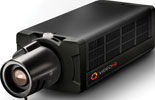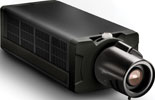

Many of the growing issues with IP video systems today, such as bandwidth, storage and maintenance costs, are the direct result of this centralised storage architecture.
The security industry has adopted a centralised storage approach for IP video surveillance systems. Manufacturers followed traditional data centre designs, assuming that it was best to use the standard architecture for information technology (IT).
Here is the problem: data centres and most IT systems are designed for many users accessing data servers in one location. This is called a 'one-to-many' model, since each data centre serves large numbers of users. Most experts assumed that this would also be the best model for security video as well, but this is wrong. Sensor networks have exactly the opposite requirements.
Video surveillance systems include dozens or hundreds, and sometimes thousands of cameras, all spread out across the network, with only a few users. Cameras supplying the data far outnumber the users, and there is no way to centrally locate those cameras. They need to be out at the edge of the network.
This 'many-to-one' architecture generates very different demands on the system. For example, typical enterprise servers spend about 50% of their time reading data stored on their hard drives, with the other 50% spent writing new data.1 Surveillance systems, however, require non-stop writing of data to record the video, 99% of the time, but only about 1% to play it back.2
Second, data centres usually need a small number of storage units to support 20 or more different enterprise functions. So, the same storage servers can be used for a wide range of applications. But surveillance by itself requires extremely large amounts of storage. “The consequence is the video requirements can put a speed bump in IT plans to reduce costs through consolidating storage,” according to Steven Titch, editor of Network Centric Security. “Plus, in video,” according to Lee Caswell of Pivot3, “each time storage capacity increases, there needs to be a commensurate increase in bandwidth. That breaks the mould.”3
“The increasing reliance on cameras for security presents storage costs that can easily spiral out of control,” according to Titch. This is why server manufacturers have been scrambling to develop better solutions for video surveillance.
Network strain
The problem with bandwidth is even more severe, since almost any large deployment of cameras will strain available WANs and wireless networks. In addition, remotely accessing video via the Internet is an increasing need. This often forces video storage closer to the edge of the network, into smaller servers placed at local sites. However, even on local area networks, where adding equipment to expand bandwidth is simple, IT managers are still concerned about the demands made by continuously streaming video cameras. They often insist on separate networks for video, to isolate the cameras and protect their enterprise information systems.
Security managers are generally just as concerned, because they cannot afford to lose video recording if the data network goes down, for maintenance or any other reason. For these two reasons, added networking costs are often required.
Hard drive failures are by far the number one cause of equipment failure with security video. If you centralise video storage, then a single point of failure puts at risk the data recorded from 16, 32 or more cameras. For this reason, IT managers require RAID storage and sophisticated management systems that can automatically redirect video streams during storage node failures.
However, traditional RAID 5 storage approaches are often inadequate.
“This issue is unique to video recording and seldom surfaces in RAID system used by other applications,” according to Carl Lindgren of Sycuan Gaming Commission, “The key is that for most applications, written data is verified during the write process.” But the continuous non-stop nature of video does not allow time to verify. “A drive could happily chug along writing data that is unreadable for a long time. Neither the system nor the operators would ever know that there is a problem,” says Lindgren. If an error occurs on more than one disk, a RAID 5 system cannot recover the lost video. This problem is forcing the move to more expensive RAID architectures.4
On top of all these issues are the skyrocketing costs for installing new data centres and maintaining them, along with the double digit growth in the numbers of servers needed in each data centre, and rapid growth in the total number of data centres.5 While servers once consumed about 50 W, before the year 2000, they now draw about 250 W each. In addition, according to Intel, you now need another 170 W to cool each server today.6

The bandwidth problem
Traditional IP cameras stream massive amounts of data across the network for recording at a central location. However, as mentioned above, only 1% of that recorded video is ever played back. This means you are taxing your networks 100X more than is necessary. You are streaming all that video across your network for the 1% that you actually need. This is the waste created by trying to force video systems into a data centric model.
Bandwidth may be getting cheaper on LANs, but the problem with video across networks is getting worse. Why? More and more network cameras are being added, with a growing demand for higher resolution and faster frame rates, and the increasing need to access the video across WANs, the Internet and wireless networks. The rising importance of cameras for security and business management makes this a growing concern.
Standard resolution cameras using the latest H.264 compression need about 500 Kbps if you want full motion video, or 150 Kbps at lower frame rates. MPEG-4 and MJPEG compression needs even more. So, how many cameras can you stream at the same time? Two, if you are lucky.
However, when you store video right in the camera, no bandwidth is needed for recording. When video is recorded in the camera, you do not need to stream the video; you can send it as a clip. This makes a big difference. To stream video, you need the full bandwidth required to play that video in real-time. When you send a clip, however, you can transmit the video at much lower data rates – it simply takes a little longer for the file to get through, like sending an e-mail attachment from a cellphone.
Reducing storage costs
If only 1% of recorded video is needed, would it not be nice to know what that 1% is when it is happening? Adding intelligence into the camera gets us closer to this ultimate ideal. Video analytics adds the ability to automatically recognise what is happening in the scene and whether it is important or not. Installers can define what should be recorded through easily configurable rules, customised to the end-users’ needs.
Unfortunately, the problem is not quite that simple, because sometimes it is what does not happen that is just as important. For example, a shopper sues a store claiming that they slipped on spilled liquid, or their car was damaged in a parking lot by a company vehicle, or a manager mistreated another employee. Sometimes it is important to show that such things never happened, and for this reason it is important to continuously record the video.
However, what we can do, as a result of having intelligence in the camera, is record at higher resolution and higher frame rate whenever something important might be happening, and we can retain that important video longer. This improves the value of the stored video, without incurring the cost of recording at high quality all the time.
Immunity to network downtime
With traditional IP cameras, if you lose network communications, your system stops recording video. Network up-time is high these days, due to rigorous IT management practices and making sure that equipment meets IT standards. However, networks do still go down. Sometimes they need to be taken off-line on purpose, during system upgrades or maintenance. But systems can also fail during critical emergencies, such as fire or intentional attacks, when surveillance video is most important.
If network communications fail, your recording fails, but if your storage server breaks down, you can lose video to dozens of cameras at a time. By recording video in the camera, you solve the first problem, and you significantly reduce the impact of the second issue, since a single hard drive failure can affect one camera at most, not dozens. This increases system and data reliability.
Simpler and more scalable
Traditional IP video systems require all of the following systems to work together, often from different suppliers:
* Network cameras.
* NVR software to manage the video recording.
* Storage servers.
* Video analytics servers.
* Added networking equipment to increase bandwidth and isolate video from the data network.
Once storage and intelligence is built into the camera, you eliminate the need for external DVRs or NVRs. You no longer have to add equipment to increase the bandwidth or to isolate surveillance video from the data systems. On top of that, you can now add 20X as many cameras onto a wireless network, or other limited bandwidth networks.

Reduced maintenance and data centre costs
Data centres typically represent 25% of the whole IT budget, and these costs are growing as much as 20% per year – far faster than IT budgets are growing.7 These expenses are hardly ever calculated into the cost of IP video surveillance systems; generally just the cost of the server itself is included. However, current estimates show that for every $1000 you spend on servers, you need to spend an ongoing $1000 per year to cover site cap-ex expenses, maintenance, electrical power for both the server and cooling equipment, and replacement costs with three-year life expectancies for servers.8
Therefore, eliminating the need for valuable data centre space, and doing away with the need for adding servers that require maintenance and power to run and cool them, means that the value of distributed storage in cameras represents a major step forward. As said above, the reason for this is: video surveillance systems are inherently sensor networks, not data processing systems.
But what about the increased cost of managing hard drives now at the edge of the network? This is an important question.
If hard drives fail in cameras every 3–5 years, as they do in servers, then this means replacing 6–16 times as many hard drives, if you have one in every camera. These HDDs will also be more expensive to service, because cameras are not centrally located. They are often mounted high on walls and poles, and other areas difficult to get at.
If hard drives run continuously in cameras, as they do in standard storage servers or DVRs, this would create a significant added problem. Fortunately, there is an elegant solution. The life expectancy of a hard drive is based on its 'power-on' hours. In other words, if you power on the hard drive one third of the time, then your hard drive will last about three times longer. That is good news, because there is a simple way to keep hard drives from being powered on continuously, as storage servers require.
Since we only need to record video from one camera, we can use solid-state memory to act as a buffer. In VideoIQ’s iCVR, we include 1 GB of solid-state memory. This is enough to store about 4-5 hours of video. Therefore, we only need to wake up the hard drive every 4-5 hours, and after that, we can put it back to sleep again.
This means the hard drive is asleep over 90% (typically 96%) of the time. This not only significantly increases the life expectancy, but also reduces power consumption as well. Therefore, the life of a typical hard drive has been extended to last longer than the 10-year lifespan of a typical camera. This not only resolves the problem of having hard drives at the edge of the network, it also solves the biggest maintenance expense with traditional IP video systems: The failure of hard drives.
The benefits of intelligence
As we can see above, intelligent storage in the camera solves the most significant problems challenging network video systems, and it significantly reduces equipment, installation and maintenance costs. It is also more scalable and simpler to use, and much more network friendly and fault tolerant.
The biggest benefits of intelligence, however, lie in the ability to transform surveillance into proactive protection. This is far more valuable than simply recording video for playback after an incident, because proactive alerts allow you to stop crime before it happens. For all of these reasons, an architecture of intelligent cameras with built-in storage will eventually transform IP video surveillance. However, as with any new design, questions always come up: What new problems does this architecture create?
The most common concern raised is over the danger of cameras being damaged or stolen. You could lose valuable stored data, since it is more vulnerable at the edge of the network. Most video integrators admit that attacks on cameras are rare, and it is more likely to see DVRs damaged or stolen – still this is a valid concern that needs to be addressed. We want the data protected.
Fortunately, video analytics in the camera provides the solution. Since the camera is smart enough to know what is an important event, it can send an alarm message along with a video clip to a remote monitoring station. Even if the station is not manned, the video clip is redundantly stored remotely from the site.
The future
The benefits of intelligent cameras with built-in DVRs are compelling today. As many users have pointed out, all of these advantages become even more significant in the years ahead. This is why so many now recognise that it represents the IP video system of the future. Let us look at some of these important trends.
Solid-state memory is getting cheaper and smaller
While today’s cameras with flash memory can only store hours or a few days of video, it is clear that in a few years, advances in solid state memory will make it cost effective to have a complete DVR in the camera. Today it is too expensive, but over the next two to three years that is going to change.
The growth of megapixel video
If there are problems with bandwidth and storage with standard resolution cameras, think of how much more of an issue this is with megapixel cameras. Even the lowest resolution HD camera – the 1 MP camera – is about 4X the resolution of a standard camera, while a 5 MP camera is 20X the resolution. That means that if you wanted to record at the same frame rate and the same quality, it would take 20X as much bandwidth and storage space.
Security as a service
Web services for video surveillance have become a hot topic these days. Huge projections in the growth of cloud computing and Software as a Service (SaaS), as a way of outsourcing data processing, has created a rush to develop video security applications to ride this wave.
One leading IP camera company has been promoting this concept and projected that hosted video might account for as much as 25% of all video applications in five years. Once again, the assumption being made is that networked video should follow the data centre model. As shown above, this mistake adds unnecessary expenses and added complexity. This is even a bigger problem for hosted video applications.
It is quite easy to show that storage in the camera is less expensive than storage in a server farm, because you do not need the added cost of trying to manage hundreds or thousands of streams of video. This recording overhead is many times the cost of the hard drives. However, the biggest downfall of the hosted video approach is the cost of bandwidth.
Conclusion
Adding intelligence and full DVR storage capabilities into cameras significantly reduces bandwidth and storage requirements, along with data centre costs. It also reduces the complexity of the installation, makes the system far more scalable, and decreases maintenance issues due to hard drive failures. System reliability and uptime are also improved. Future trends and technology make this architecture even more compelling.
All of these advantages are gained because traditional networked video systems follow a data centre model, while sensor networks run far more efficiently with distributed memory and intelligence. This is why intelligent cameras with storage will transform IP video surveillance.
This article has been shortened, the full version can be found at http://www.videoiq.com/uploads/whitepapers/VideoIQ_StorageWP_8_10.pdf
References
1 http://netcentricsecurity.com/Articles/2009/04/01/Building-Better-Storage-Solutions.aspx
2 http://ipvideomarket.info/report/advantages_of_raid6_over_raid5_for_video_surveillance
3 http://netcentricsecurity.com/Articles/2009/04/01/Building-Better-Storage-Solutions.aspx
4 http://ipvideomarket.info/report/advantages_of_raid6_over_raid5_for_video_surveillance
5 Data centres: How to cut carbon emissions and costs, from McKinsey on Business Technology, 2008.
6 Green-memory movement takes root, by Mark LaPedus, 18 May, 2009 issue of EE Times.
7 Data centres: How to cut carbon emissions and costs, from McKinsey on Business Technology, 2008.
8 The Invisible Crisis in the Data Center: The Economic Meltdown of Moore’s Law, by Kenneth G. Brill, Uptime Institute, 2007.
For more information contact VideoIQ Africa, +27 (0)82 789 2010, [email protected], www.videoiq.co.za

© Technews Publishing (Pty) Ltd. | All Rights Reserved.